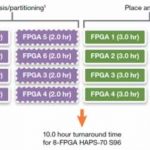Qualcomm has made the long-awaited foray into the ARM-based server chipsets and the trade media is presenting its 24-core SoC prototype as a challenger to Intel’s hegemony in the cloud server market. Is it so?… Read More
S2C ships UltraScale empowering SoFPGA
Most of the discussion around Xilinx UltraScale parts in FPGA-based prototyping modules has been on capacity, and that is certainly a key part of the story. Another use case is developing, one that may be even more important than simply packing a bigger design into a single part without partitioning. The real win with this technology… Read More
Xilinx Beats Altera to the First FinFET FPGA!
Why do I stalk the FPGA industry? Well, FPGAs are an important part of the fabless semiconductor ecosystem for two reasons: 1.) They enable very cost effective design starts which are the life’s blood of the semiconductor industry and 2.) FPGA prototyping allows designers to verify their designs before committing to silicon and… Read More
Prototyping the Future of Semiconductors!
With major semiconductor mergers and acquisitions running rampant in 2015 (more than double the M&A activity in 2014), the question is where will we go from here? There are many different ways to slice this but for this blog let’s talk about the thousands of semiconductor professionals that will be changing jobs as a result … Read More
Xilinx Skips 10nm
At TSMC’s OIP Symposium recently, Xilinx announced that they would not be building products at the 10nm node. I say “announced” since I was hearing it for the first time, but maybe I just missed it before. Xilinx would go straight from the 16FF+ arrays that they have announced but not started shipping, and to the… Read More
Xilinx is a Software Company
If you think of Xilinx the word that immediately comes to mind is FPGA. After all they were one of the pioneers of the space. FPGAs are a means of implementing hardware, and the main implementation methodology is RTL-based. This compares to writing software and compiling it for a microprocessor, which is the main software implementation… Read More
NIWeek: Xilinx Inside
Being from Britain, NI always means Northern Ireland when I see it. After all the official name of my country is the United Kingdom of Great Britain and Northern Ireland, giving us the same problem as the United States of America, the full name is a mouthful. So we abbreviate the country to UK and call ourselves British or even Brits.… Read More
More FPGA-based prototype myths quashed
Speaking of having the right tools, FPGA-based prototyping has become as much if not more about the synthesis software than it is about the FPGA hardware. This is a follow-up to my post earlier this month on FPGA-based prototyping, but with a different perspective from another vendor. Instead of thinking about what else can be done… Read More
Taking prototyping beyond prototypes
Everyone has heard the expression, “Half the job is having the right tool.” In the case of FPGA-based prototyping, however, the right tool for the job is only the beginning. What teams really need to think through is what exactly should be done with an FPGA-based prototyping tool?
The obvious answer is prototyping an SoC, pre-silicon.… Read More
Conquering the Next IoT Challenges with FPGA-Based Prototyping
The need for ever-connected devices is skyrocketing. As I fiddle with my myriad of electronic devices that seem to power my life, I usually end up wishing that all of them could be interconnected and controlled through the Internet. The truth is, only a handful of my devices are able to fulfill that wish, but the need is there and developers… Read More



Quantum Computing Technologies and Challenges